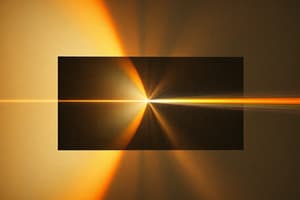Podcast
Questions and Answers
What is light dispersion?
What is light dispersion?
Light dispersion is the separation of light into its individual colors or wavelengths as it passes through a medium.
What causes refraction dispersion in light dispersion?
What causes refraction dispersion in light dispersion?
Refraction dispersion is caused by the speed of light in a medium depending on the wavelength of the light.
Explain diffraction dispersion in light dispersion.
Explain diffraction dispersion in light dispersion.
Diffraction dispersion occurs when light interacts with an obstacle or slit, causing the wavelengths to separate.
How does the refractive index influence dispersion?
How does the refractive index influence dispersion?
What effect does the speed of light in a medium have on dispersion?
What effect does the speed of light in a medium have on dispersion?
Describe the phenomenon of separation of colors due to dispersion.
Describe the phenomenon of separation of colors due to dispersion.
What is the main application of prisms in the context of light dispersion?
What is the main application of prisms in the context of light dispersion?
How does dispersion compensation help in telecommunications?
How does dispersion compensation help in telecommunications?
What is the main limitation associated with dispersion in optical systems?
What is the main limitation associated with dispersion in optical systems?
What is crosstalk in the context of telecommunications?
What is crosstalk in the context of telecommunications?
What is the fundamental behavior of light that understanding light dispersion helps to explain?
What is the fundamental behavior of light that understanding light dispersion helps to explain?
How does dispersion differ from simple refraction or reflection in terms of complexity?
How does dispersion differ from simple refraction or reflection in terms of complexity?
Flashcards are hidden until you start studying
Study Notes
Light Dispersion in Optics
Light, the invisible force that illuminates our world, consists of electromagnetic waves that travel in various colors. As they pass through different materials, these waves of light can experience dispersion, a fascinating phenomenon that separates them into their constituent colors. In this exploration of optics, we'll delve into the intricacies of light dispersion, its causes, and its implications.
What Is Light Dispersion?
Dispersion is the separation of light into its individual colors, or wavelengths, as it passes through a medium. The colors travel at different speeds due to their distinct wavelengths, resulting in the "rainbow" effect we observe when sunlight is refracted through water droplets in the air, such as during a rainbow or inside a prism.
Causes of Dispersion
Dispersion occurs because the speed of light in a medium depends on the wavelength of the light. Shorter wavelengths, such as blue light, travel slower than longer wavelengths, such as red light. This difference in speed leads to a phenomenon called refraction dispersion.
Another cause of dispersion is diffraction dispersion. This phenomenon occurs when light encounters an obstacle or slit. The wavelengths interact differently with the obstacle or slit, leading to their separation.
The Role of Refractive Index
The refractive index of a medium, which is the ratio of the speed of light in a vacuum to its speed in that medium, plays a significant role in dispersion. A higher refractive index indicates that light travels slower in the medium, and the difference in speed between the various colors will be more pronounced.
Applications of Dispersion
Dispersion has numerous practical applications, including but not limited to:
-
Prisms: As mentioned, prisms are commonly used to demonstrate light dispersion, separating white light into its constituent colors. In fact, prisms are used in various applications, such as converting sunlight into energy in solar cells, dispersing light in x-ray optics, and analyzing spectral lines in astronomy.
-
Chromatography: This laboratory technique separates components of a mixture based on their dispersion properties, such as their size or polarity.
-
Dispersion compensation: In telecommunications, dispersion compensation is used to counteract the negative effects of dispersion on transmitted digital data.
-
Diffractive optics: This technology involves the manipulation of light using diffraction, which can lead to the dispersion of light in unique ways.
Limitations and Challenges
Dispersion has inherent limitations and challenges, including:
-
Abberation: Dispersion can lead to chromatic aberration, which causes blurring and distortion in optical systems.
-
Crosstalk: In telecommunications, dispersion can lead to crosstalk between different channels, reducing the efficiency of transmission.
-
Complexity: The dispersion of light requires a more intricate understanding of wave behavior than simple refraction or reflection.
Conclusion
Light dispersion is a fascinating phenomenon that occurs when light interacts with different materials or obstacles. This phenomenon has numerous applications and implications across various fields, including telecommunications, spectroscopy, and diffractive optics. Understanding light dispersion is key to understanding the fundamental behavior of light and its applications in modern technology.
Studying That Suits You
Use AI to generate personalized quizzes and flashcards to suit your learning preferences.



